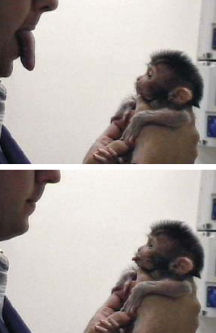Copycat Monkeys: Macaque babies ape adults’ facial feats
Scientists for the first time have established that for a brief period after birth, baby monkeys imitate facial movements made by people and adult monkeys. This copycat capacity, until now observed only in human and chimpanzee infants, seems to have evolved in all these primates as a way to jump-start newborns’ face-to-face communication with adults, say evolutionary biologist Pier F. Ferrari of the University of Parma in Italy and his colleagues.

Between 3 and 7 days after birth, macaque babies smacked their lips and stuck out their tongues just as an experimenter did, the researchers report in the September PLoS Biology. Adult macaques make these facial gestures during friendly or cooperative interactions, such as mutual grooming.
The baby monkeys stared impassively when experimenters opened and closed their mouths or right hands. A rotating, colored disk about the size of a face also elicited no reaction.
Preliminary observations of free-ranging macaques by Ferrari’s group further suggest that newborns mimic their mothers’ lip smacking and tongue protrusion.
“I think that [infant] imitation developed in species in which face-to-face communication predominates over other channels of communication,” Ferrari says.
Researchers have generally held that imitation in the service of social learning occurs only in people and apes. Ferrari’s team questioned that assumption after the recent discovery in macaque brains of mirror neurons. These cells, also found in people, vigorously react both when an individual performs an action and when he or she watches it being executed by another (SN: 5/24/03, p. 330: Available to subscribers at Repeat After Me).
The scientists tested 21 baby macaques at 1, 3, 7, 14, and 30 days after birth. In each session, an experimenter held an infant monkey at face level and briefly exhibited a neutral expression. A random series of displays then followed, consisting of tongue protrusion, mouth opening, lip smacking, hand opening, and disk spinning, each separated by a return of the neutral expression.
Many day-old infants smacked their lips frequently after viewing a mouth opening and closing, but they didn’t mimic what they had seen.
Of 16 macaque babies tested when 3 days old, 13 copied tongue protrusions, lip smacking, or both. By day 7, imitation of the experimenter had largely disappeared except for continued mimicry of lip smacking by 4 animals. By day 14, all imitation had stopped.
It’s not clear why some babies, whether macaque, chimp, or human, fail to imitate facial gestures, Ferrari says. His team plans to track the monkeys into adulthood to see whether the imitators and the others later differ in temperamental or sensory traits. The team will also examine whether infant monkeys that imitate develop any special social or cognitive abilities later on.
In contrast to macaques, human and chimp babies typically begin mimicry at 2 to 3 weeks of age and continue for several months, as infants become emotionally tuned to their mothers. Macaque imitation occurs in a briefer time span because these primates grow up and gravitate into a social network much faster than people or apes do, Ferrari surmises.
Psychologist Kim A. Bard of the University of Portsmouth in England calls the new report “simply a terrific study.” Investigators can now determine in various monkey species whether the first week of life represents a critical period for learning via imitation, says Bard, who has studied imitation among chimp infants.
“We have not yet tapped the full extent of imitative abilities in nonhuman primates,” she says.